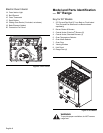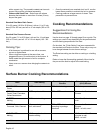
English 14
• With propane (LP) gas, slight yellow tips on the primary
cone are normal.
• The flame should burn completely around the burner
cap. If it doesn’t, check that the cap is positioned
correctly on the base and that the ports are not
blocked.
• The flame should be stable with no excessive noise or
fluttering.
WARNING:
The burning of gas cooking fuel can create small
amounts of Carbon Monoxide, Benzene,
Formaldehyde and Soot. To minimize exposure
to these substances, the burners should be
adjusted by a certified installer or agency to
ensure proper combustion. Ensure proper
ventilation with an open window or use a
ventilation fan or hood when cooking with Gas.
Always operate the unit according to the
instructions in this manual.
Cookware Recommendations
WARNING:
To avoid risk of serious injury, damage to
appliance or cookware, please observe the
following:
• Bakeware, such as large casserole pans, cookie
sheets, etc. should never be used on the cooktop.
• Placement of large stock pots should be staggered
when used on the cooktop.
• Select the base diameter to match the diameter of the
flame. The diameter of the flame should be the same
size as the pan base or slightly smaller. Oversize or
under size pans sacrifice cooking performance. A
5-1/2" (140 mm) base size is generally the smallest
recommended.
• Balance is important for stability and even cooking. The
handle must not be heavier than the pan and tilt it
unevenly. A pan must sit level on the grate without
rocking or wobbling.
• Food packaged in aluminum foil should not be placed
directly on the burner grate. Aluminum foil can melt
during cooking.
Figure 13: Flame Color
Secondary
Cone
Primary
Cone
Light Blue
Dark Blue
Figure 14: Base Diameter
Figure 15: Balanced Pan
2” (51 mm)


















